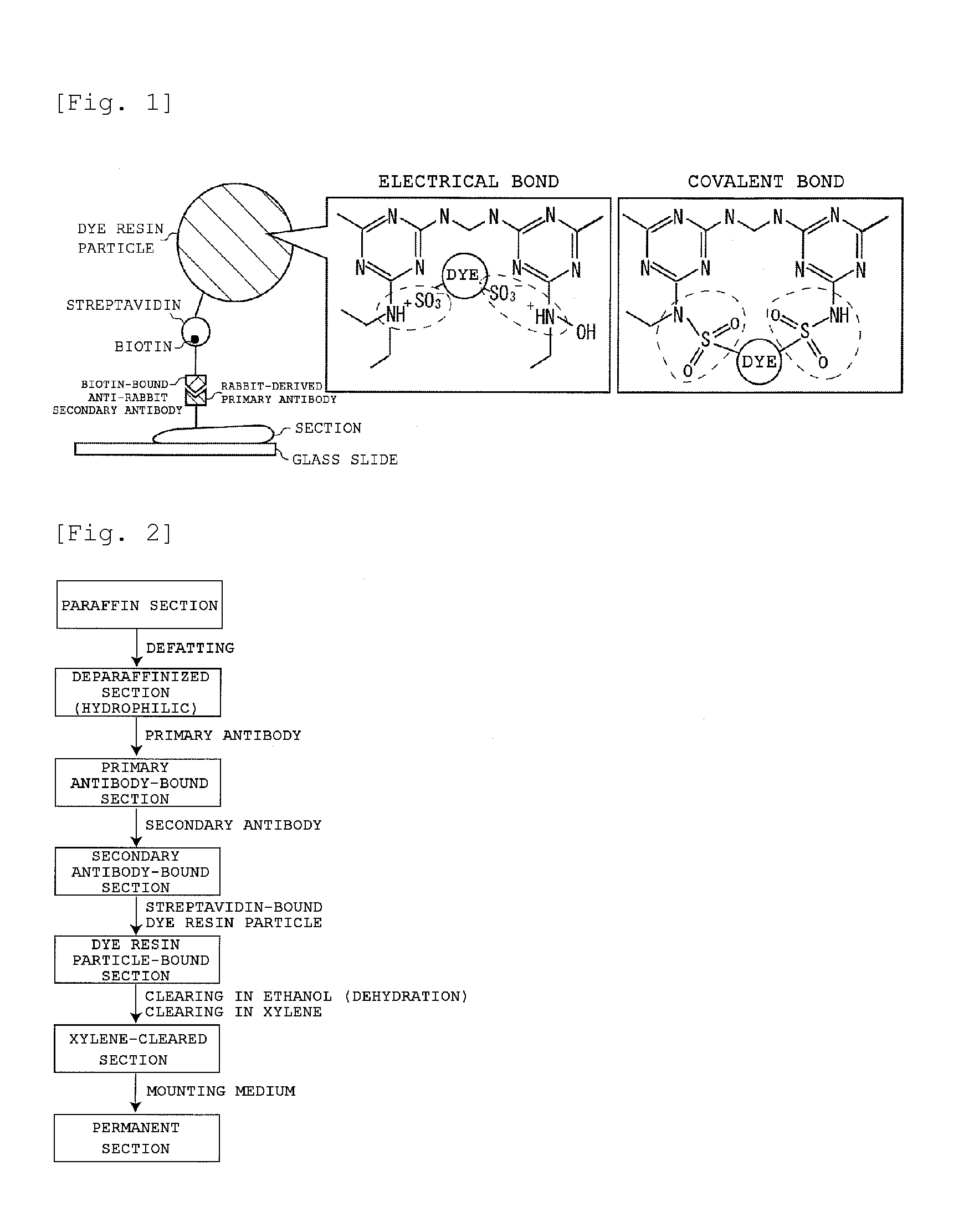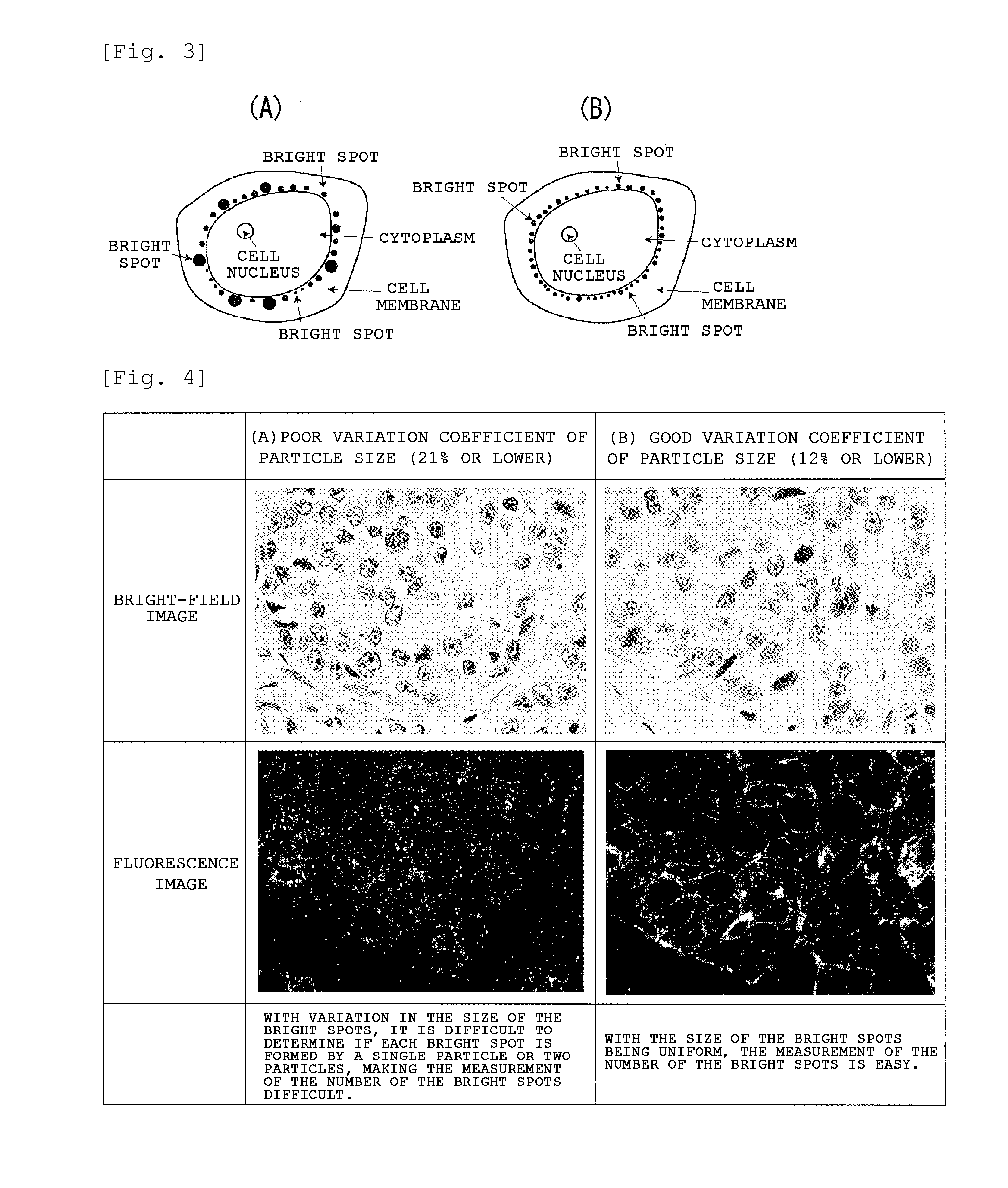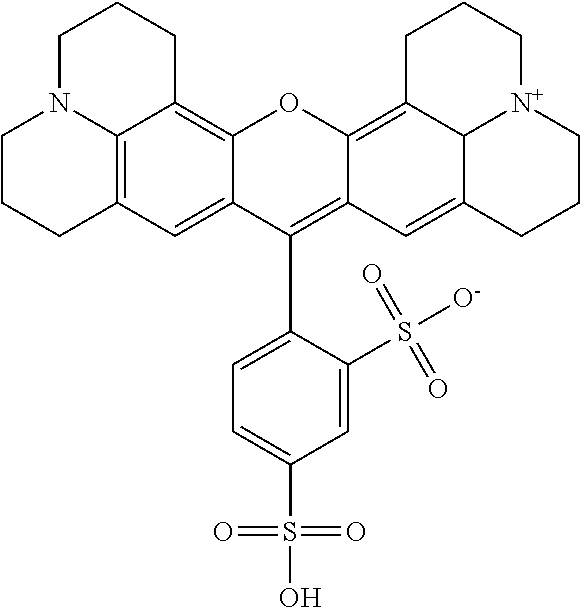Staining agent for staining tissue, production method for staining agent for staining tissue and tissue staining kit including staining agent for staining tissue
a technology for staining agents and tissue, which is applied in the direction of instruments, organic dyes, material analysis, etc., can solve the problems of difficult to make a tissue specimen transparent, difficult to estimate the actual amount of antigens or the like based on the depth of color, etc., and achieve the effect of improving the accuracy of fluorescence signal evaluation
- Summary
- Abstract
- Description
- Claims
- Application Information
AI Technical Summary
Benefits of technology
Problems solved by technology
Method used
Image
Examples
example 1
Polymelamine Particle Encapsulating Compound 1-1
[0145]As a fluorescent dye, 14.4 mg of Compound 1-1 (Sulforhodamine 101, manufactured by Sigma-Aldrich) was added and dissolved in 22 mL of water. Then, to the resulting solution, 2 mL of 5% aqueous solution of an emulsifier for emulsion polymerization, EMULGEN (registered trademark) 430 (polyoxyethylene oleyl ether, manufactured by Kao Corporation), was added. This solution was heated to 70° C. with stirring on a hot stirrer, and 0.65 g of a melamine resin material, NIKALAC MX-035 (manufactured by Nippon Carbide Industries Co., Ltd.), was subsequently added.
[0146]To the resulting solution, as a surfactant, 1,000 μL of 10% aqueous solution of dodecylbenzenesulfonic acid (manufactured by Kanto Chemical Co., Inc.) was further added, and the resultant was heated with stirring at 70° C. for 50 minutes. Thereafter, the resultant was further heated with stirring at 90° C. for 20 minutes. The resulting dispersion of dye-resin particles was wa...
example 2
Polyurea Particle Encapsulating Compound 1-1
[0160]The production of dye-resin particles and the others were carried out in the same manner as in Example 1, except that 0.80 g of a urea resin material was used in place of 0.65 g of the melamine resin material NIKALAC MX-035 (manufactured by Nippon Carbide Industries Co., Ltd.). The thus obtained urea resin contained a large number of amino groups in its skeleton and thus had a positive charge. The urea resin material was urea which was produced by a known method and had a methylolation degree of 40 to 70%.
example 3
Polyxylene Particle Encapsulating Compound 1-1
[0161]The production of dye-resin particles and the others were carried out in the same manner as in Example 1, except that 0.80 g of a xylene resin material NIKALAC Y-50 (manufactured by Fudow Co., Ltd.), 0.20 g of butyl isocyanate and 0.20 g of NIKALAC MX-035 (manufactured by Nippon Carbide Industries Co., Ltd.) were used in place of 0.65 g of the melamine resin material NIKALAC MX-035 (manufactured by Nippon Carbide Industries Co., Ltd.). The thus obtained polyxylene resin contained a large number of amino groups and thus had a positive charge.
Examples 4, 7, 10, 13, 16, 19, 24, 27, 30 and 34
Polymelamine Particles Encapsulating Compounds 1-2 to 3-2
[0162]The production of dye-resin particles and the others were carried out in the same manner as in Example 1, except that Compound 1-1 was changed to Compound 1-2 (Example 4), Compound 1-3 (Example 7), Compound 1-4 (Example 10), Compound 1-5 (Example 13), Compound 1-6 (Example 16), Compound...
PUM
 Login to View More
Login to View More Abstract
Description
Claims
Application Information
 Login to View More
Login to View More - R&D
- Intellectual Property
- Life Sciences
- Materials
- Tech Scout
- Unparalleled Data Quality
- Higher Quality Content
- 60% Fewer Hallucinations
Browse by: Latest US Patents, China's latest patents, Technical Efficacy Thesaurus, Application Domain, Technology Topic, Popular Technical Reports.
© 2025 PatSnap. All rights reserved.Legal|Privacy policy|Modern Slavery Act Transparency Statement|Sitemap|About US| Contact US: help@patsnap.com



